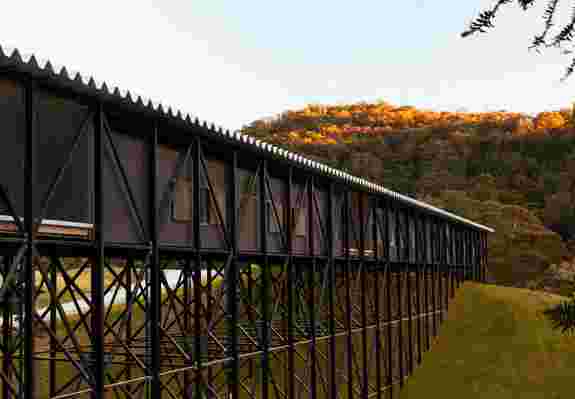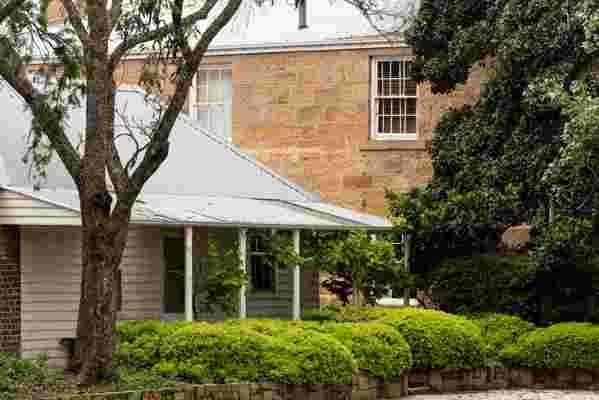In places where the effects of climate change are as frequent as they are devastating, sustainable architecture is perhaps as—if not more—important as aesthetics. Bundanon , the 1,000-hectare arts destination in regional New South Wales, Australia, is taking sustainability to a rather unheard of level. Designed by the Australian firm Kerstin Thompson Architects (KTA), the new Art Museum and Bridge for Creative Learning is intended to respond and adapt to both current and future climate disasters . The nearly 530-foot-long bridge is positioned so high that floodwaters can flow beneath it rather than on it. What’s more, the art museum is hidden within a hill to protect itself against wildfires. And if this wasn’t impressive enough for a building, this beautifully constructed fire-resistant infrastructure happens to house a $46.5-million, 4,000-piece contemporary art collection.

The Bridge is built on stilts to avoid inevitable floods. In fact, it was designed in such a way that it would be able to adapt to and even benefit from climate change-induced events. Because flood waters flow beneath The Bridge, the water is harvested and stored for later use. Plus, the whole structure is powered by solar energy.
The two new structures, which opened to the public on January 29 (with an official ceremony and festival of events coming later in the year), were constructed to be environmentally responsible. “Art museums have historically run with high energy consumption,” Bundanon CEO Rachel Kent explains. “Both cooling and heating systems are needed, for example, to maintain a stable temperature critical to the conservation of artworks. With the current climate crisis, this is clearly unsustainable. It is vital that museums and galleries, like other industry sectors, actively seek solutions that aim to have a net-zero energy target.”
Chief among the energy-saving elements at Bundanon’s new art museum is the solar panels that power the entire museum. One of the many structures on the massive property that will house these solar panels includes the home where famed Australian artist Arthur Boyd and his wife Yvonne lived before donating their estate to Australia in 1993. Though the estate covers a large swath of ground—2,471 acres, to be exact—it’s split up into two clusters. The first groups the Homestead, Arthur Boyd Studio, and Artists in Residence Complex, while the second one houses the Boyd Education Centre, the new KTA–designed Art Museum, and The Bridge.

Australian artist Arthur Boyd and his wife Yvonne lived on the enormous estate until they donated it in the early 1990s. His studio was only steps away from the couple’s home.
The 541-foot-long by 30-foot-wide bridge borders the museum and comprises 34 guest rooms, dining spaces, and a public cafe—amenities nearly ever other traditional bridges lack. Plus, The Bridge is where Bundanon and KTA’s sustainably-minded ambitions come into play: It’s powered by the aforementioned solar panels, but also enlists passive temperature management and black water treatment, while harvesting and storing rainwater. Kent adds, “It would be ideal if these solutions and more could be integrated into the museum sector as a standard.”
Perhaps as important as the sustainability of Bundanon’s new additions is the landscaping, which celebrates the surrounding area’s natural heritage—indigenous and pastoral. Of course, there’s also a subtle homage to the Boyds, with their domesticated garden that has been integrated with the bucolic clearings. For the highly specific landscaping, the Bundanon visionaries turned to landscape architects Wraight Associates and Craig Burton, who rather than place the primary focus on the aesthetic, made ecology the centerpiece of the grounds. Like nearly every aspect of Bundanon, there’s more to the landscaping than trees and gardens. But that was the architects’ point. They wanted to design groundbreaking structures that are as beautiful as they are full of purpose. The Bridge and museum aren’t there for decoration; they’re responding to climate change in a way no other art-centric architecture has before.
And, of course, the Australian architects wanted to honor the estate’s original owners. Though Bundanon’s latest additions further solidify the Boyds’ legacy, the enormous artistic estate is more than a place to look at beautiful things in a natural oasis—it’s a step-by-step manual that details how to prevent the disastrous effects of climate change.

Leave a Reply